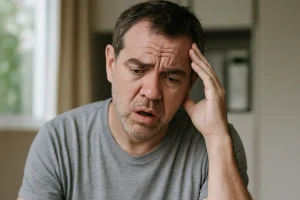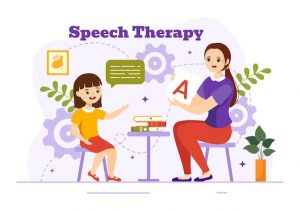Understanding Aphasia: Your Guide to Therapy
By Rajini D
Last Updated: April 20, 2024
Welcome to “A Guide to Aphasia Therapy,” a journey into understanding the complexities of aphasia and the path toward reclaiming the power of communication. Aphasia, a language disorder that impacts speaking, reading, writing, and understanding spoken words, can profoundly affect daily life, altering the way individuals connect with the world around them. It’s not just about losing words; it’s about finding new ways to express thoughts, feelings, and needs in a world that suddenly seems much quieter.
In this guide, crafted with care for those touched by aphasia, we embark on a journey together. Whether you’re someone navigating the challenges of aphasia firsthand or a supportive friend or family member, this guide is tailored for you. We aim to offer knowledge that enlightens and practical advice that empowers, making the silent world of aphasia a little less daunting.
Also Read: Decoding the Differences: Aphasia and Apraxia Unveiled
Understanding Aphasia
Aphasia can feel like being a stranger in one’s own language landscape, where words that once flowed effortlessly now seem elusive or out of reach.
What is Aphasia?
Aphasia is a language disorder that affects the ability to communicate. It’s like having words, sentences, and ideas locked away without a key. People with aphasia may find it challenging to speak, understand others, read, or write. But it’s important to remember that this doesn’t affect intelligence. The person behind the aphasia is still there, with thoughts and feelings as rich as ever.
Different Types of Aphasia
Aphasia comes in various forms, each with its unique challenges:
- Broca’s Aphasia: Often called non-fluent aphasia, where speaking becomes laborious. People can understand language well but struggle to form complete sentences.
- Wernicke’s Aphasia: Or fluent aphasia, where individuals can produce many words, but they may not make sense to the listener. Understanding spoken language is also difficult.
- Global Aphasia: The most severe form, combining significant difficulties in both speaking and understanding speech.
- Primary Progressive Aphasia: A rare form that gradually impairs language capabilities, unlike other types that occur suddenly.
Causes and Symptoms
So, what causes aphasia? Most commonly, it’s due to damage to the left side of the brain, where our language capabilities reside. This damage can result from a stroke, head injury, brain tumor, or infection.
The symptoms vary widely, but they pivot around communication challenges:
- Speaking in short or incomplete sentences.
- Speaking in sentences that don’t make sense.
- Substituting one word or sound for another.
- Trouble understanding conversations.
- Difficulties with reading and writing.
Understanding aphasia is the first step towards empathy and support for those navigating this silence. Each person’s experience with aphasia is unique, but the goal of aphasia therapy remains constant: to unlock the doors to communication once again, enabling voices to be heard and understood.
Also Read: Understanding Transcortical Sensory Aphasia
The Path to Recovery
Understanding and diagnosing aphasia is crucial, as it opens the door to tailored therapies and strategies that can significantly improve quality of life. Here, we outline the steps toward diagnosis and the core aspects of aphasia therapy.
Getting Diagnosed
The road to managing aphasia begins with a comprehensive medical evaluation. It’s a critical step that paves the way for effective treatment and recovery. Speech-language pathologists (SLPs) play a central role in this process, offering specialized expertise to assess language difficulties and devise a plan tailored to each individual’s needs.
Diagnosing aphasia typically involves non-invasive tests, such as CT scans or MRI imaging, to pinpoint the areas of the brain affected. These technologies provide detailed images of the brain’s structure, helping medical professionals understand the extent and location of damage without the need for surgical intervention. This phase is about gathering information without overwhelming you with technical details to ensure the most effective treatment plan can be developed.
Aphasia Therapy: The Core of Recovery
Once a diagnosis is made, the focus shifts to aphasia therapy, the cornerstone of the recovery process. The aim here is not just to rehabilitate but to reignite the ability to communicate, catering to the unique challenges each person faces. Therapy often includes:
- Speech-Language Therapy: Through one-on-one sessions, group therapy, or even online platforms, SLPs work to improve speaking, listening, reading, and writing skills. The therapy is highly personalized, evolving over time to match progress and shifting goals.
- Personalized Treatment Plans: Each journey through aphasia is unique, necessitating a customized approach. Plans may incorporate traditional speech exercises, the use of technology and apps, or alternative communication methods like sign language or picture boards.
Know more about our article Understanding Transcortical Sensory Aphasia
Living with Aphasia: Tips and Strategies
Living with aphasia introduces unique challenges in daily communication, but embracing effective strategies and tools can open new doors to connection and understanding.
Enhancing Communication: Practical Advice
- Patience is Key: Communication with aphasia takes time. Whether you’re expressing yourself or trying to understand someone with aphasia, patience is fundamental. Allow extra time for conversations without rushing.
- Simplify, Don’t Infantilize: Use simple language and short sentences, but maintain an adult tone. It’s about making communication easier, not talking down to someone.
- Visual Aids: Pictures, gestures, and writing can be incredibly helpful. Visual aids can support or even substitute verbal communication, making interactions less frustrating.
- Establish a Clear Context: Starting a conversation with a clear topic can help individuals with aphasia understand and participate more effectively.
- Yes/No Questions: Simplify choices and responses by framing questions so they can be answered with a simple ‘yes’ or ‘no.’
- Encourage All Forms of Communication: Remember that communication isn’t just about speaking. Encourage non-verbal forms of expression like painting, drawing, or using communication apps.
Effective Communication Strategies for Aphasia
| Strategy | Description | Tips |
|---|---|---|
| Use Simple Language | Simplify your speech to enhance understanding. | Avoid complex sentences. Use clear, concise words. |
| Visual Aids | Use pictures, gestures, and writing to support verbal communication. | Keep commonly used pictures or symbols handy. Use gestures naturally to complement speech. |
| Establish Context | Make it easier to understand and participate in conversations by setting the topic clearly upfront. | Start conversations with a clear topic statement. Use visual topics cues if possible. |
| Yes/No Questions | Frame questions to be answered with a simple ‘yes’ or ‘no’ to facilitate easier responses. | Phrase inquiries where the answer can be a straightforward yes or no, reducing the need for complex verbal responses. |
| Encourage All Forms of Communication | Recognize and support the use of all possible communication methods. | Welcome non-verbal cues, written notes, and any other forms of communication the person with aphasia can use comfortably. |
Wellness Hub: Your Partner in Aphasia Therapy
As we’ve journeyed together through the complexities of aphasia, exploring its impacts, understanding its nuances, and uncovering strategies for better communication, it’s clear that navigating this path requires not just knowledge and patience but also support. This is where Wellness Hub steps in, aligning perfectly with your journey toward understanding and managing aphasia.
Wellness Hub stands as a beacon of hope and assistance for individuals touched by aphasia and their families. Recognizing the unique challenges faced by each person, we offer a plethora of resources aimed at enhancing the quality of life and communication. From connecting you with experienced speech-language pathologists to providing access to the latest in augmentative and alternative communication (AAC) devices, Wellness Hub is dedicated to supporting you at every step of your journey.
Conclusion
As we wrap up this guide on aphasia, remember that though aphasia makes communication tough, there’s hope. With the right help, understanding, and therapy, anyone can improve. It’s a unique journey for everyone, filled with its own challenges and victories. But it’s important to keep going, stay hopeful, and always work on getting better, bit by bit.
Wellness Hub is here to support you on this journey. We’re all about offering the help and community you need. You’re not alone in this. With every step forward, remember you’re making progress, finding new ways to express yourself and connect with the world around you.
Frequently Asked Questions:
1. What is aphasia and how does it affect communication?
Aphasia is a language disorder that impacts a person’s ability to communicate. It can result in difficulties with speaking, understanding others, reading, and writing, but it doesn’t affect intelligence. Despite these challenges, many individuals find effective ways to communicate through therapy and support.
2. Can aphasia be treated?
Yes, aphasia can be treated through various therapies. Speech-language therapy is the most common treatment, focusing on improving an individual’s ability to communicate by relearning and practicing language skills. Personalized treatment plans and the use of assistive devices can also significantly help.
3. How can I support a loved one with aphasia?
Supporting a loved one with aphasia involves patience, understanding, and encouragement. Use simple language, provide visual aids, and encourage all forms of communication. Being part of their therapy journey and engaging in support groups can also be beneficial.
4. Are there any tools or technologies that help people with aphasia?
Yes, there are many tools and technologies designed to help people with aphasia. Augmentative and Alternative Communication (AAC) devices, speech-generating devices, and specialized computer applications can aid in improving communication abilities.
5. How can I find a support group for aphasia?
Support groups for aphasia can be found through healthcare providers, speech-language pathologists, and online platforms like Wellness Hub. These groups offer a space for sharing experiences and tips and receiving emotional support from others who understand the challenges of living with aphasia.
6. Is recovery from aphasia possible?
While aphasia recovery varies greatly among individuals, many people see improvements in their communication skills over time with therapy. The extent of recovery can depend on the aphasia’s cause, the area of the brain affected, and the therapy’s timing and intensity.
7. Where can I learn more about managing aphasia?
Websites like Wellness Hub offer a wealth of resources on managing aphasia, including articles, therapy resources, and access to a supportive community. These resources aim to empower individuals with aphasia and their families with knowledge and support for navigating the condition.
8. What role do speech-language pathologists play in aphasia therapy?
Speech-language pathologists (SLPs) are crucial in diagnosing and treating aphasia. They assess the individual’s language abilities and tailor therapy plans to improve speaking, understanding, reading, and writing skills. SLPs also provide valuable resources and strategies for effective communication, making them integral to the recovery process.
9. Can technology play a part in aphasia rehabilitation?
Yes, technology plays a significant role in aphasia rehabilitation. From specialized apps that focus on language skills to advanced speech-generating devices, technological tools can enhance communication for those with aphasia. These technologies offer alternative ways to communicate, support therapy exercises, and help maintain social connections.
10. How important is early intervention in the treatment of aphasia?
Early intervention in aphasia treatment is highly important. Beginning therapy as soon as possible after the onset of aphasia can significantly impact the effectiveness of treatment and the speed of recovery. Early intervention helps leverage the brain’s natural ability to adapt and reorganize, potentially leading to more substantial improvements in communication skills.
About the Author:
Rajini Darugupally
M.Sc., Speech-Language Pathologist (9+ years of experience)
Rajini is a passionate and dedicated Speech-Language Pathologist with over 9+ years of experience, specializing in both developmental speech and language disorders in children and rehabilitation in adults. Driven by a desire to empower each individual to find their voice, Rajini brings a wealth of experience and a warm, genuine approach to therapy.
Currently, at Wellness Hub, she thrives in a team environment that values innovation, compassion, and achieving results for their clients.
Connect with Rajini to learn more about how she can help you or your loved one find their voice.
Book your Free Consultation Today
Parent/Caregiver Info:
Client’s Details:
* Error Message







